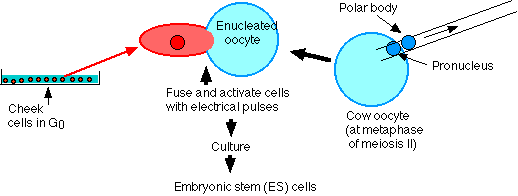Culturing Human Embryonic Stem (ES) Cells
In earlier pages, I have described how
The techniques used in the early steps of each process have now been achieved with human cells.
Human Embryonic Stem (ES) Cells
A research team led by James Thomson of the University of Wisconsin reports in the 6 November 1998 issue of Science that they have been able to grow human embryonic stem (ES) cells in culture.
At the time of implantation, the mammalian embryo is a blastocyst.
 It consists of the
It consists of the
- trophoblast - a hollow sphere of cells that will go on to implant in the uterus and develop into the extraembryonic membranes
- placenta
- umbilical cord
- amnion
- inner cell mass (ICM) that will develop into the baby.
The cells of the inner cell mass are considered pluripotent; that is, each is capable of producing descendants representing all of the hundreds of differentiated cell types in the newborn baby, including
Their process
- Remove the trophoblast cells from a human blastocyst (these were extras not needed for in vitro fertilization (IVF)
- separate the cells of the inner cell mass and culture them on a plate of "feeder" cells (mouse fibroblasts were used)
- isolate single cells and grow them as clones
- Test the clones
The results
- each successful clone maintained a normal human karyotype (unlike most cultured human cells - HeLa cells, for example)
- these cells had high levels of the enzyme telomerase, which maintains normal chromosome length and is characteristic only of cells with unlimited potential to divide ("immortal")
- when injected into SCID mice, these cells formed teratomas; tumors containing a mix of differentiated human cell types, including cells characteristic of
SCID = severe combined immunodeficiency.
These mice lack a functioning immune system (have neither T cells nor B cells) and so cannot reject foreign tissue. (Some rare inherited diseases of humans are also called SCID. They produce the same phenotype but the molecular defects are not the same as in the mice.) |
Making ES cells from the differentiated cells of an adult
Researchers at the firm of Advanced Cell Technology (in Worcester, Massachusetts) announced on 11 November, that they had been able to convert adult human cells into cultured cells that appear to have the properties of embryonic stem cells; that is, pluripotent and, perhaps, "immortal". (However, they have yet to publish evidence supporting their claim.)

Their process is quite like that used to produce Dolly.
- Cells were removed from an adult human (Jose Cibelli, one of the researchers). Both his cheek cells and his white blood cells were tried.
- Cow oocytes were enucleated
- human cell and enucleated egg were fused using a pulse of electricity
- the resulting cell was grown in culture.
The Goals of These Achievements
Both these procedures have been used with other animals (mice and sheep). In both those cases, the products were implanted in the uterus of the host animal and grew into a complete animal (cloned mice and Dolly, respectively). Do these workers plan to do the same with their human cells? They assure us that they do not.
So what are their goals?
Human embryonic stem cells have the potential to
- teach us about the process of human embryonic development, its genetic control, etc.
- if the proper signals can be discovered, it may be possible to cause these cells to differentiate along a particular pathway, e.g., to form insulin-secreting beta cells of the islets of Langerhans.
- such cells might be able to replace lost or non-functioning cells in a human patient (e.g., with insulin-dependent diabetes mellitus - IDDM)
- such cells might be transformed with the DNA needed to express a gene missing in the transplant recipient
- such cells might be engineered to reduce the risk of transplant rejection.
16 November 1998
 It consists of the
It consists of the
